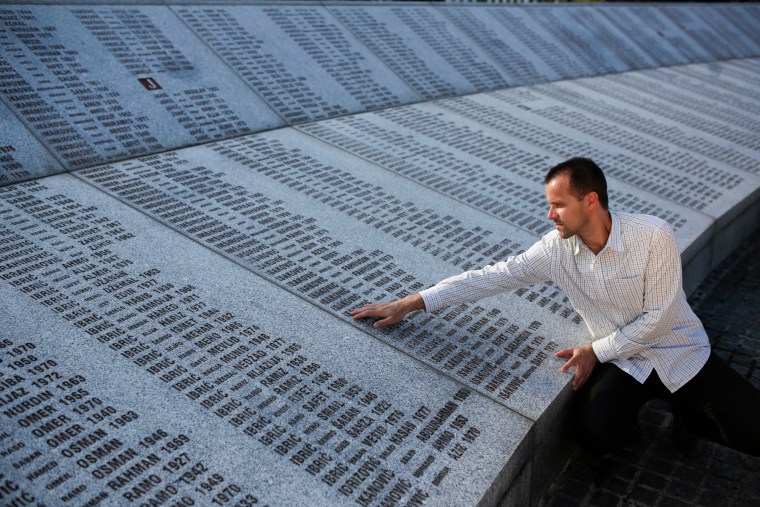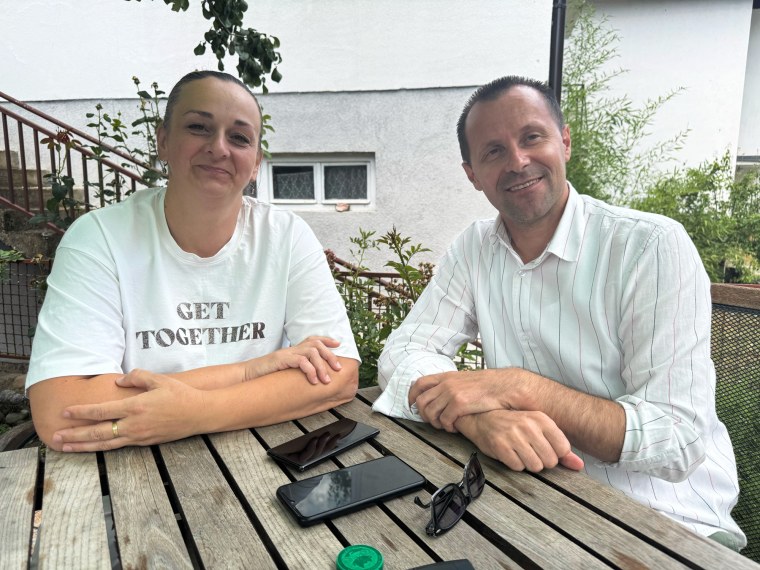SREBRENICA, Bosnia — Nedzad Avdic stood on a gravel plateau with four men and boys with their hands tied behind their backs, preparing for death. Just 17, Avdic had been captured by Bosnian Serb forces days earlier. Now, he stood yards from an execution squad.
Avdic said he heard shots, felt sharp pain in his right side and right arm and blacked out. When he woke up, more prisoners were being lined up for execution. When the small truck that brought him to the site drove away, Avdic and another wounded man escaped in the darkness. After walking to the woods for days, they crossed into Muslim-controlled central Bosnia.
Last week, Avdic recounted his experience to members of the German parliament at an event in Berlin marking the 30th anniversary of the fall of the United Nations-protected “safe area” of Srebrenica. Two international courts have ruled that Bosnian Serbs’ systematic killing of male Bosnian Muslim prisoners — at least 7,000 in total — was the first genocide in Europe since World War II.
The following day, members of the far-right Alternative for Germany, or AfD party, argued in parliament that the mass killings did not constitute genocide. “The Serbs shot men there, but generally spared women and children,” Alexander Wolf said in a speech.
A second AfD member, Martin Sichert, invoked a conspiracy theory, warning that Muslims were waging a “birth jihad” in Germany, a reference to Muslim immigrants’ someday outnumbering Germans. “Srebrenica reminds us to end multiculturalism before it’s too late,” Sichert warned.
As disinformation spreads online, denialism about war crimes — both past and ongoing— is growing increasingly common worldwide, experts warn. From current conflicts in Ukraine, Israel and Gaza to past atrocities in Syria, Bosnia and Rwanda, as well as the Holocaust, basic facts are now disputed or dismissed.
Denialism is proving politically profitable, as well. In February, the AfD won the second most seats in Germany’s parliament, the best showing by a far-right party since World War II. In Bosnia, a local Serb leader, Milorad Dodik, has gained support by spreading conspiracy theories about Srebrenica, calling it “an arranged tragedy.” He dismisses the identification of 6,981 victims — part of the largest DNA identification project in history— as a hoax.
Dodik’s office and the AfD did not immediately respond to requests for comment or proof of their claims.
At a conference in Srebrenica marking the 30th anniversary of the mass killings here, the heads of the Kigali Genocide Memorial in Rwanda and the Auschwitz-Birkenau and Stutthof concentration camp museums in Poland warned that spreading lies online about war crimes has also become financially profitable. War crimes denialism generates so much traffic online that making money — not political or ideological gain — appears to motivate some of its purveyors.
At one point, the directors discussed whether better influencers might help, and several of them agreed that they could.

Avdic is determined to be one of them. As denialism spreads, he is more determined than ever to use what is left of his life to speak for the men and boys who died beside him on that gravel 30 years ago.
“It’s becoming more aggressive day by day,” he said, referring to denialism. “You have to know that we are all foreign bodies on this Earth, and we will all evaporate naturally sooner or later.”
A U.N.-protected ‘safe area’
I first met Avdic 30 years ago covering the war in Bosnia as a reporter for The Christian Science Monitor. After the fall of Srebrenica, rumors spread that Bosnian Muslim men were describing mass executions. Avdic, then a shell-shocked teenager whose father was later found in a mass grave, was one of nine men who told me they had survived mass executions. When I later visited the gravel plateau beside an earthen dam in the village of Petkovci, I found two human femurs.
Avdic and his father were among the roughly 10,000 Bosnian Muslim men who fled Srebrenica on foot when Bosnian Serb forces attacked in July 1995. The surrounded town had been declared an internationally protected “safe area,” but the United States, Europe and 600 Dutch UN peacekeepers did little to protect it
Women, children and elderly men took refuge at a large battery factory that Dutch peacekeepers had turned into their main base. And men, most of them unarmed, set off through the woods on a 60-mile trek to Muslim-controlled central Bosnia.
When Serb forces attacked the column, Avdic and his father were separated in the chaos. “I lost him,” Avdic recalled. “I lost him immediately.” He continued walking with strangers but was eventually captured. Two days later, he and other men were taken to the gravel plateau, and the executions began.
Needing to speak
For the next 12 years, Avdic testified at war crimes trials about the executions under a pseudonym and lived far from Srebrenica, fearing for his safety. In 2007, he returned to Srebrenica, his hometown. He and other Bosnian Muslims felt a duty to return to the area and preserve its Muslim community. Avdic, who had grown up in a village outside the town and also lost four uncles and three cousins in the killings, found being in Srebrenica comforting.
“I have less nightmares,” he said, shrugging his shoulders. “I cannot explain it.”
In 2014, when he visited the execution site during an event with mothers of the victims, he was filled with a desire to speak publicly about the mass killing he survived.
“When I came to the place, something forced me to say something; I felt a strong need to talk,” he said. “Words started to flow, something stronger than me.”

He met his wife, Elvisa, a Bosnian Muslim survivor whose uncle and cousin also died in the executions, in Srebrenica in 2008. The following year, they married. Today, Nedzad works as a manager at a company in Srebrenica that produces parts for luxury car interiors. Elvisa works at a local meteorological station. They have three daughters who attend local school alongside Serb children. Serbs and Muslims coexist but generally don’t discuss the war.
“Hatred destroys, first of all, those who hate,” Avdic said.
In recent years, Avdic has given dozens of speeches about the massacres in multiple countries and called for the protection of civilians in Ukraine and Syria. Speaking about Srebrenica is difficult but cathartic. “It was my choice to go to Berlin,” he said. “It is not something that I wish. It is emotional, and it is difficult for me.”
Local Bosnian Muslims have transformed the cavernous former car battery factory that Dutch U.N. peacekeepers used as a base into a museum documenting the genocide. Across the street, the headstones of the thousands of Muslim men and boys killed in the massacres cover a lush green field and hillside.
In recent years, though, Muslims have slowly left Srebrenica, many of them citing economic and safety concerns. Once a majority-Muslim town, Srebrenica is now roughly half-Serb, half-Muslim.
Elvisa, Avdic’s wife, said she worries about her children’s future.
“I was 13 years old then in 1995. My daughter is now 13 years old,” she said. “Now, I’m more emotional about that time. When we are older, we care more and we feel more.”
“Our grandmother was killed,” she added. “They cut her throat.”
Denial and threats
Avdic said provocations still happen, including when a local priest once played Serb nationalist songs to taunt Muslim residents.
“He will die with his evil,” Avdic said of the priest.
As denialism spreads, Serb nationalists have grown more defiant. In nearby towns, Avdic is sometimes recognized and mocked by them.
“I’m not afraid of them,” he said, though he acknowledged the danger. “You never know what could happen, because I’m a witness.”
Avdic and his wife are torn. Leaving Srebrenica might be better for their children, but Avdic believes it is his duty to raise his family here and speak for the men and boys who died beside him.
“I will die proud,” he said. “And I believe my children will be proud they were born here.”